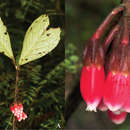Description
(
anglais
)
fourni par Phytokeys
Terrestrial shrubs with arching branches, < 1 m tall; stems and twigs somehow flatten, caniculated lengthwise, apparently glabrous, the hairs inconspicuous (< 0.1 mm long), unicellular and eglandular (= minute hair type), bark brown and smooth. Axillary buds not observed. Leaves alternate, originated very close together, pseudoverticillate with clusters of 3–5 leaves separated by leafless sections several centimeters long; petiole caniculate, basally pulvinate, 4–12 mm long, glabrate, minute type of hair; lamina chartaceous, bullate in vivo, obovate, (17.5–)20.5–24 × (6.5–)12–14.2 cm (at least 24 cm long, apices incomplete), base attenuate and decurrent, margin entire and eciliate, apex missing in herbarium specimens but probably acuminate, glabrate on both sides, adaxially with caducous minute hairs, abaxially the hairs of arachnoid type, ca. 1 mm long, very thin, multicellular and eglandular; laminar glands absent; venation pinnate, with up to 4 orders visible adaxially in dry specimens, midrib adaxially impressed and abaxially raised, at least 9–11 secondaries per side, these alternate or subopposite, evenly dispersed along the lamina, ascending, adaxially flat and abaxially raised, brochidodromous, intersecondaries frequent. Inflorescence an axillary, solitary, 6–8-flowered raceme; inflorescence bracts, floral bract, and bracteoles alike, persistent, chartaceous, cream-reddish-colored, ovate, 1.6–1.8 × 1.5–2 mm, margin entire and inconspicuously ciliolate, the hairs of the minute type but a few are multicellular, apex obtuse or acute, glabrous on both sides, venation obscure, the bracteoles are different in having apex acute and more abundant marginal multicellular hairs that are fused in masses of fimbria toward the base; peduncle 4 mm long, rachis 5–10 mm long, both red-brown, glabrate, the hairs of the arachnoid type, also covered with minute, whitish warts in vivo (inconspicuous when dried, though imparting rough look); pedicel red-brown, articulate with calyx, 12–14 mm long (17 mm in vivo), with the same indumentum and warts of the rachis; bracteoles 2, basal, supopposite to alternate. Flowers 5-merous, actinomorphic, diplostemonous. Calyx red-brown, ellipsoid, 5-angled, the angles sharp and opposite to the sinuses, 8–9.2 mm long (10.5–11 mm in vivo), sparsely tomentulose with a combination of arachnoid and minute hair types, specially warty distally; tube ellipsoid, 6–7.4 mm long (8.5–9 mm in vivo); limb erect, 1.8–2 mm long; lobes deltate, 1 × 3.2 mm long, (1.5–1.7 × 4 mm in vivo), margin scariose (except at apex) and sometimes broken up in segments or with a few multicellular and eglandular hairs, apex acute; sinuses obtuse (U-shaped); aestivation unknown. Corolla dark pink with white throat and lobes, very fleshy, not bistratose, urceolate, 5-angled, 12–14 mm long (19 mm in vivo), 4–5.2 mm diam. (ca. 10 mm in vivo), 2.4–3 mm wide at throat (ca. 5 mm in vivo), puberulous without with a combination of arachnoid and minute hairs, the indumentum more abundant distally, glabrous within; lobes ovate, ca. 1.1 × 1.1 mm (ca. 2 × 2 mm in vivo), apex acute, reflexed at maturity; aestivation valvate. Stamens 10, equal, 8.7–9 mm long, included, not adherent to corolla; filaments free, long-triangular, 2.3–2.5 mm long, marginally glabrate, with minute hairs; anthers 8.3–8.5 mm long, connective spurless; thecae 4.1–4.5 mm long, slightly prognathous, without basal appendage, papillate; tubules 2, free, straight, 4–4.2 mm long, smooth, dehiscing by introrse slits, 2.7–3.5 mm long. Nectary not pulvinate, slightly concave in vivo, glabrous; style 15–17 mm long, included; stigma punctiform. Berry unknown.
- licence
- cc-by-3.0
- droit d’auteur
- Paola Pedraza-Peñalosa
- citation bibliographique
- Pedraza-Peñalosa P (2015) New blueberry and mortiño relatives (Ericaceae) from northwestern Colombia PhytoKeys (49): 33–58
- auteur
- Paola Pedraza-Peñalosa

